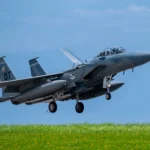BlackSea Technologies has unveiled its new Modular Autonomous Surface Craft (MASC) family of unmanned surface vessels (USVs), aiming to contribute significantly to the U.S. Navy’s fleet modernization efforts. Designed with modularity and multi-mission flexibility in mind, the MASC series reflects growing naval interest in distributed maritime operations and autonomous force multipliers.
Introducing the MASC Family: A Modular Approach to Naval Autonomy
The MASC USV family includes three core variants—MASC-M (Medium), MASC-L (Large), and MASC-X (Extra-Large)—each tailored for different mission sets such as intelligence, surveillance and reconnaissance (ISR), mine countermeasures (MCM), anti-submarine warfare (ASW), and logistics resupply. The vessels are designed around a common open-architecture control system that supports rapid payload integration and mission reconfiguration.
According to BlackSea Technologies’ announcement at the 2025 Sea-Air-Space Expo in National Harbor, Maryland, the MASC series is built on a scalable hullform optimized for stability and endurance in contested littoral environments. The company emphasized that all variants are designed for autonomous or optionally manned operation with minimal crew intervention.
- MASC-M: Approximately 12 meters in length; ideal for ISR and electronic warfare missions.
- MASC-L: Around 20 meters; supports mine countermeasure modules or light ASW sensors.
- MASC-X: Over 30 meters; capable of carrying heavy payloads including containerized logistics or large sensor arrays.
The modularity is enabled through standardized payload bays and mission packages that can be swapped within hours at forward operating bases or afloat support ships.
Mission Sets Aligned with Distributed Maritime Operations
The U.S. Navy’s Distributed Maritime Operations (DMO) concept emphasizes smaller, networked platforms capable of operating independently across wide ocean areas while contributing to a larger sensor-shooter grid. The MASC USVs are explicitly designed to fit into this paradigm by offering persistent presence without risking high-value manned assets.
Key mission profiles under development include:
- ISR & EW: Equipped with EO/IR sensors, passive RF detection suites, and SATCOM relay nodes for over-the-horizon targeting support.
- MCM: Integration with synthetic aperture sonar (SAS) towfish or expendable mine neutralizers via modular launch-and-recovery systems.
- ASW: Deployment of dipping sonars or passive acoustic arrays combined with AI-enabled threat classification algorithms.
- Cargo & Logistics: Containerized supply modules enabling resupply of forward-deployed units without manned convoy risk.
This versatility aligns closely with recent U.S. Navy experimentation under programs like Ghost Fleet Overlord and Task Force 59’s operational testing in CENTCOM AOR using commercial-derived USVs such as MARTAC’s Devil Ray T38 and L3Harris’ Sea Hunter derivatives.
C4ISR Integration & Autonomy Stack
The MASC series incorporates a layered autonomy architecture developed in collaboration with DARPA-affiliated research centers. The autonomy stack includes adaptive navigation algorithms using fused GNSS/INS data plus obstacle avoidance via radar/LiDAR fusion. Mission planning is conducted through a secure C2 interface compatible with NATO STANAG protocols including Link-16 interoperability where required.
Cybersecurity is reportedly baked into the system design from inception under a “zero trust” framework compliant with DoD Cybersecurity Maturity Model Certification (CMMC) Level 3 standards. Communications resilience includes redundant SATCOM uplinks and low-probability-of-intercept/detection (LPI/LPD) mesh networking options for denied environments.
The vessels also feature onboard edge computing capabilities allowing real-time data processing for ISR applications without requiring constant reachback—critical in contested electromagnetic spectrum conditions anticipated in peer conflict scenarios such as Indo-Pacific contingencies.
Status of Prototyping & Testing
As of Q3 2025, BlackSea Technologies has completed sea trials of two pre-production prototypes—one each based on the MASC-M and MASC-L platforms—off the coast of Virginia under observation by NAVSEA representatives. Initial testing focused on autonomous navigation accuracy, endurance validation (>72 hours continuous ops), remote C2 handoff between shore stations and afloat command nodes, as well as payload integration trials using simulated sonar modules and EO/IR turrets provided by FLIR Defense Systems.
The company expects full-rate production readiness by late FY2026 pending additional testing milestones under an Other Transaction Authority (OTA) agreement reportedly signed earlier this year under NavalX’s small business innovation initiatives. No formal program-of-record designation has yet been made public by the Navy; however, sources suggest that elements of PMS-406 Unmanned Maritime Systems Office are monitoring progress closely for potential inclusion into future Large Unmanned Surface Vessel (LUSV) force structure planning beyond FY2027 POM cycles.
Industrial Partnerships & Future Roadmap
To accelerate time-to-fielding while reducing cost per unit through commercial off-the-shelf components where feasible, BlackSea Technologies has partnered with several defense subcontractors including:
- Kongsberg Maritime: Navigation suite integration including doppler velocity logs (DVLs) and inertial reference units;
- L3Harris Technologies: Comms packages including tactical datalinks;
- Sierra Nevada Corporation: AI software modules for adaptive behavior modeling;
The roadmap includes plans for armed variants equipped with non-lethal deterrents or loitering munitions pending policy guidance from OPNAV N9 regarding rules-of-engagement thresholds for autonomous lethal systems—a topic still under review following Congressional hearings on autonomous weapons ethics earlier this year.
Tactical Implications & Strategic Significance
If adopted at scale within the next five years, the MASC USVs could significantly reduce operational burden on crewed platforms while enhancing maritime domain awareness across contested regions like the South China Sea or Persian Gulf chokepoints. Their low cost relative to destroyers or LCS hulls enables attritable deployment models suited to saturation tactics against adversary A2/AD networks—a key concern highlighted in recent RAND Corporation wargaming studies on Pacific conflict scenarios.
The unveiling of the MASC family underscores an accelerating shift toward unmanned maritime systems as integral—not auxiliary—components of future naval force structures. Whether these systems transition from prototype to program-of-record will depend not only on technical performance but also doctrinal acceptance within legacy naval hierarchies still adjusting to manned-unmanned teaming paradigms at sea.









